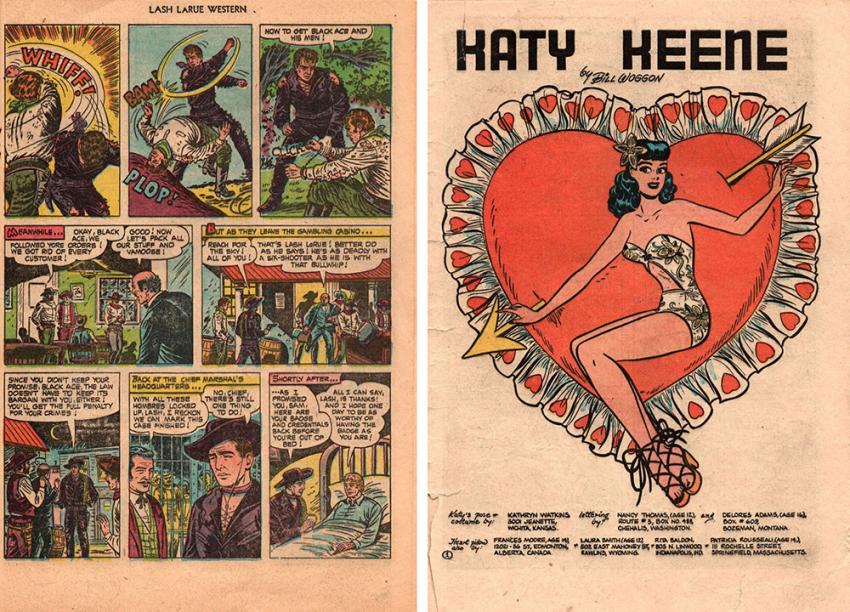MAGGIE’S WORLD BY MAGGIE THOMPSON
Maggie’s World 091
Remembering the Forgotten

Maybe you’ve had one of those moments: I was in a used bookstore and discovered a number of “clearance” bundles. The bundles were tightly wrapped bunches of comic books, and only the front cover of the top one and the back cover of the bottom one were identifiable.
I’d figured that the bundles consisted of random comics but I wanted the ones on top of each of the three (cheap) packages, so I bought them.
When I got them home, I was surprised and delighted to find that each package consisted of issues that were similar to the one on top. And the reason I’d wanted two of them was that I used to read those titles when I was about 10 but hadn’t collected. I’d kept an eye out for some but hadn’t found any cheap—until now.
That brought to mind the fact that many series I used to buy ended when I was otherwise occupied.

What was going on?
There were a number of convulsions in the marketing world of comic books. Dell, for example, tended its own newsstands for a long time. You didn’t necessarily find DC series alongside Dell series alongside Classics Illustrated titles alongside Fawcett comics.
And there were different genres. Remember Warner Bros.’ “Mary Jane and Sniffles” stories? They ran in Looney Tunes and Merrie Melodies Comics alongside stories featuring Bugs Bunny and Porky Pig. Sniffles first appeared in 1939 in the movie cartoon “Naughty But Nice” (created by Chuck Jones). And way back in the day, the character of Mary Jane was added to his stories. Initially, she was able to use magic sand to take her down to mouse size: “Magic sand, magic sand, make me small at my command.” But I think some kids were actually throwing sand in their hair in imitation, so the magic was eventually changed a bit, and the magic words were “Poof, poof, piffles, make me just as small as Sniffles.” Simple.
But I digress.

There was an enormous variety of magazines in comic book formats. Sometimes, comic books were linked to movies being released. The comic book adaptations let us revisit films via Dell’s Four-Color series. Sometimes there were movie or radio or TV series featuring characters so entertaining and popular that they could provide ongoing new stories whether or not their other formats produced many stories themselves. (In the 1940s and 1950s, I almost never saw Donald Duck cartoons in theaters—but Carl Barks turned out many, many classics anonymously. And some of those are now being reworked into TV stories.)
There were anthology comics devoted to horror, gangsters, romance, sports, cowboys, jungle folks, science fiction, and the proverbial funny animals. And then there were ambitious campaigns to keep comic books from kids entirely. The artform didn’t get shut down, but it was a near thing. And the 1954 Comics Magazine Association Code, which meant some genres of comics (crime and horror) just went away.
(And, by the way, because of the different distribution systems, would-be readers often had to visit a variety of stores in order to find all the comics that were published each week. Even if the kids cared about completing a collection, it doesn’t mean a specific store owner cared whether all the copies went on the newsstand.)
The Direct Market
In 1977, Phil Seuling set up a distribution company with which to supply comic book shops, and at that time much of the focus of comics was on fantastic characters, especially in stories that presented a variety of super-abilities and the impact that those abilities would have on people who were involved.
And the customers enjoyed the stories and, often, preordered what they preferred.
Characters who had entertained especially the younger readers found their circulations suffering in competition. John Jackson Miller’s Comichron website has recorded circulation figures from Statements of Ownership, and, when the statements began in 1961, the highest circulations were for Uncle Scrooge and Walt Disney’s Comics and Stories. (Superman and Superboy followed.)
When Miller analyzed comics shop sales (as differentiated from Statements of Ownership), by 1991, they seemed to be wall-to-wall superheroes. The industry was booming, but—at least where customers could find all the current series—masks and capes were everywhere.
Mind you, genres have evolved, and (for example) the Archie cast of characters is still very much out and about. But, on the other hand, I’m enjoying the variety of reprints that are beginning to find their way to my shelves. And now I’ve got bundles of more memories waiting to be opened.

In addition …
Well, heck. L. Frank Baum (1856–1919) collaborated with artist W. W. Denslow (1856–1915) to produce The Wonderful Wizard of Oz in 1900, and, four years later, Baum began his collaboration with the artist John R. Neil (1877–1943). The world of Oz was so intriguing that others eventually continued the series in a variety of venues, and The Wizard of Oz film was a success in 1939. But that film had so locked the characters into a specific approach that Return to Oz in 1985 was deemed too dark, and that was that.
Or was it?
Because today’s creators returned to the stories a while ago, and Eric Shanower and Skottie Young adapted some of Baum’s novels for a new audience. Have you seen their versions?
Hey, what are characters that you used to enjoy that might find new audiences today, if creators revisited them?
Me? I’m going to settle down to a stack of stories featuring Fox and Crow. I’m curious to revisit characters I haven’t seen for—gosh!—more than half a century. (And, yes, I’m well aware they evolved beyond their simple beginning in Columbia cartoons.)
Maggie’s World by Maggie Thompson appears the second Tuesday of every month here on Toucan!
Filed Under